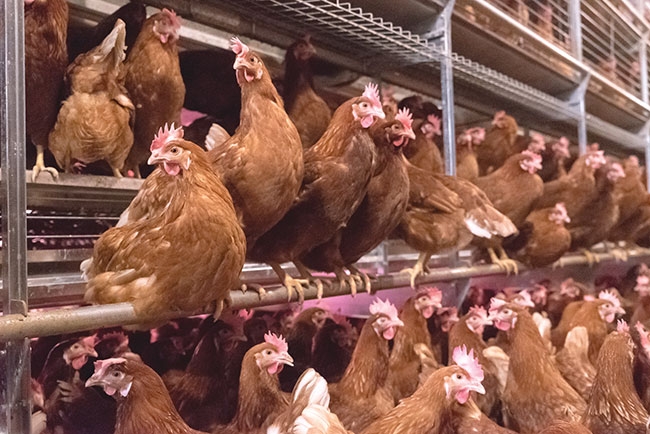
Hen welfare in aviary systems
By CPRC
Features Research Welfare Alternative poultry housing Animal Housing Animal Welfare annex Cage free Canada Egg production Livestock Production Livestock Research Phasing Out Conventional Research Researchers studied locomotive development and skills of pullets and laying hens in cage-free systems. photo credit: Big Dutchman
Researchers studied locomotive development and skills of pullets and laying hens in cage-free systems. photo credit: Big DutchmanResearch shows that under natural conditions, domestic fowl spend 70 per cent of their active time foraging by walking on the ground because their flight abilities are limited. When threatened or roosting, domestic hens seek elevated refuges. For roosting, birds fly up to the lowest branch of a tree and seek higher elevation by flying branch-to-branch, whereas they descend by flying directly to the ground. Hens use their wings only for brief escape flights.
The conventional cage system is being phased out in Canada and will be replaced by single-tier or multi-tier systems; commonly known as aviary systems. These complex housing systems enhance opportunities for hens to express natural locomotion. However, research shows that complex housing systems increase the risk of bone breakages, foot disease and behaviour that may be detrimental to hen welfare.
The problem and approach
Several designs of non-caged systems are commercially available but outcome-based animal welfare indicators are more prevalent in non-caged systems. These system designs have not been determined from a biological point of view to prevent injuries and it is unknown whether birds raised in alternative housing systems may be overtaxed in their locomotion skills.
Dr. Alexandra Harlander from the University of Guelph and her research team aim to investigate the locomotive development and skills of pullets and laying hens and to assess differences in them across strains. The intention of the research is to provide scientifically-based recommendations with respect to freedom of locomotion to improve the design of multi-tier systems to ensure that converting to non-caged systems in Canada results in the desired improvement of hen welfare.
The findings and outcomes
Layer chicks prefer horizontal to inclined surfaces and to remain on ground surfaces but use elevated horizontal surfaces as early as two weeks of age. Strain differences in use of space were observed, with a white-feathered strain of layer chicks utilizing the space above the ground more frequently. Young pullets expressed the greatest level of high-intensity physical activity and brown-feathered strains allocated less time towards low-intensity physical activity compared to white-feathered strains. Chicks and adult laying hens performed walking behaviour in order to climb 40-degree inclines, and performed wing assisted incline running or aerial ascent on steeper inclines. White-feathered strains performed more wing associated locomotor behaviour compared to brown-feathered strains.
Additionally, when birds are experienced at climbing inclines, the time they require for sensory processing or decision making varies directly with the degree of the challenge before them. Whether a bird utilizes a direct or indirect pathway when ascending to perch varies by strain, but does not vary if there is footpad dermatitis.
The research provided descriptions of the development of leg and wing locomotion in the use of ramps and perches by laying hens. These results indicate that improving space use in rearing aviaries can be accomplished by introducing lower perches, platforms and ramps/ladders to accommodate age-dependent locomotor abilities. Additionally, system designs providing less than 40-degree inclines, which are easily navigated by chicks and adult hens, minimize bird stress in aviaries and are recommended.
Finally, the results highlight that overcrowding, visual constraints and poor physical health all reduce perching performance. The results of this research should help the laying industry adapt the environments of aviary systems to maximize the welfare of laying hens.
This research was funded by the Canadian Poultry Research Council (CPRC) and was part of the Poultry Science Cluster 2, which was supported by AAFC as part of Growing Forward 2, a federal-provincial-territorial initiative. The research additionally received funding from Egg Farmers of Canada.
The Canadian Poultry Research Council, its board of directors and member organizations support and enhance Canada’s poultry sector through research and related activities. For more details, call 613-566-5916, email info@cp-rc.ca or visit www.cp-rc.ca.
Print this page